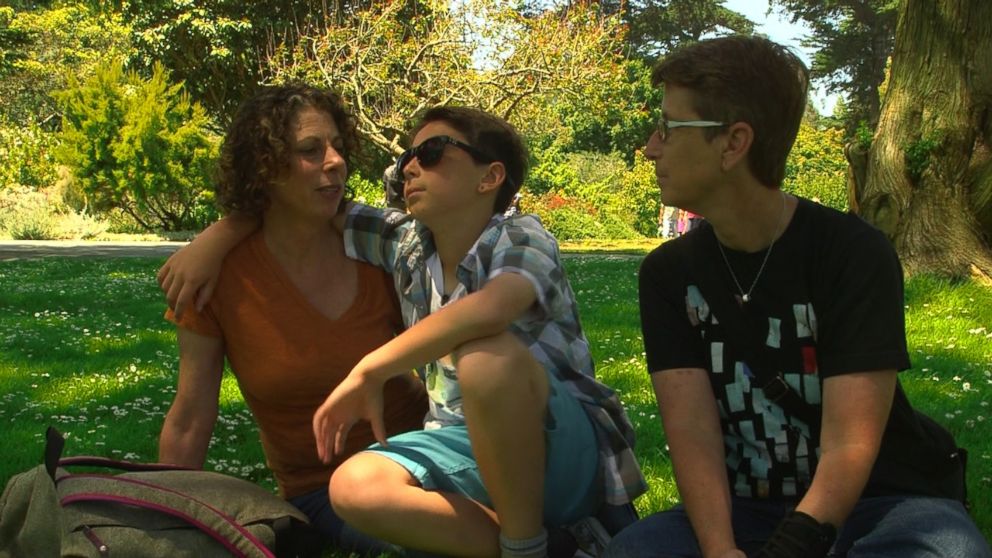Company Claims New Glasses Will Help Color-Blind People Perceive Colors Better
Enchroma says its lenses help the brain make distinctions between colors.
— -- A new type of glasses may help people who are color blind see the world in a whole new way.
The Berkeley, California-based company EnChroma developed glasses with lenses that contain a special vertical filter that blocks out certain wavelengths, which helps the brain make distinctions between colors, according to the company’s chief scientist Don McPherson.
EnChroma glasses do have some competitors, including O2 Amp and the Color Correction System lenses. The EnChroma glasses, which cost up to $450 a pair, also don’t cure color blindness, McPherson said, but they “help people perceive colors better.”
“We’re selling these very quickly,” McPherson said. “As soon as we order 500, 1,000 pairs, they are sold.”
Initially, McPherson said he developed the glasses as protective eyewear for surgeons.
“They were made for blocking certain wavelengths of light for laser surgery,” said McPherson.
But one day, McPherson said he discovered another purpose for them while playing ultimate Frisbee with a friend who was color blind.
“He borrowed my glasses and said, ‘I can see the cones on the field,’” McPherson recalled. “For the first time in his life, he could see and differentiate these two things and the little light bulb went on above my head.”

EnChroma’s glasses are for enhancing color vision, McPherson said, but some critics are skeptical. Dr. Mark Fromer, an attending ophthalmologist at Lenox Hill Hospital in New York, doesn’t believe these glasses can change the color-blind eye’s ability to see true colors.
“They are not getting the rainbow. They are getting an aid. They are getting an optical device,” Fromer told “Nightline.”
But McPherson disagrees, saying that EnChroma can help give people with color blindness an improved quality of life.
“The world is wonderfully colorful, and to not fully experience that is a shame,” he said.
To test out EnChroma’s promises, “Nightline” embarked on a non-scientific study with three color-blind people: a fifth-grader named Maddox Rochman-Romdalvik, Danielle Castro, an artist from San Francisco, and Oscar Puente from Queens, New York, who dreamed of being a fighter pilot until he discovered his colorblindness prevented it.
All three people took EnChroma’s online color blind test before trying the glasses. The test predicted Maddox had only a 30 percent chance the glasses would work. Danielle had a 75 percent chance, and Oscar scored 90 percent.
Maddox and Castro took the Ishihara Color Vision test, which uses different colored dots in various patterns, called Ishihara Plates, to determine partial or complete color deficiency, without the EnChroma glasses on. It’s a test that many ophthalmologists call the gold standard for color blindness tests to determine. After the test, It was determined that Maddox had red-green colorblindness, the most common type, which EnChroma said its glasses correct. Castro took the same test, which also yielded similar results to Maddox’s.

Then they both put on a pair of EnChroma glasses. Maddox went to the San Francisco Botanical Garden to try out the glasses, but when he looked around he said he didn't see anything different. When Danielle tried the glasses, she was able to see a stark difference in several colors at once.
“Wow. They’re actually-- they do something,” Danielle told “Nightline” while looking around her. “It’s kind of intense actually. To see colors for the first time the way they—I don’t even know if it’s the way they are meant to be seen because I have never been able to.”
Across the country in New York, Puente tried on a pair of EnChroma’s glasses with his fiancee and was taken aback at the colors he could see in a bed of flowers.
“Woah, I can see what you were saying about these leaves being purple,” Puente told “Nightline.” “They look crazy. They look like something out of a Dr. Seuss.”
He then looked at a traffic light and had an even bigger reaction.
“I can see that! Oh gosh, I’ve never seen streetlights have color before,” Oscar said, starting to tear up. “Oh, wow. Sorry, I’m getting a little emotional about a streetlight.”
After testing the glasses outdoors, Maddox and Castro retook the Ishihara test with the EnChroma glasses on. For Castro, her results were unchanged, but McPherson said he could explain why.
“The Ishihara test is not a valid test for measuring color deficiency. We’ve never used it for the simple reason that the test is not designed to be used with a filter,” said McPherson.
McPherson said the company used during a different color blindness test in their clinical trials called the Farnsworth test, which uses trays of small disks with different hues on them.
Puente took the Farnsworth test with his longtime ophthalmologist Dr. Stewart Levine of Queens, New York, first without the EnChroma glasses and then with them on, but it appeared that he did worse on the Farnsworth test wearing the glasses.
“Let’s think of it this way: If I have a black and white TV and I put on special color glasses, I am not going to see color TV,” Dr. Fromer explained. “Are you going to create new colors with these glasses? Absolutely not.”
But Castro and Puente said they couldn't care less about the test results. Oscar has since bought one pair and said he’s buying another.
“It was pretty amazing, a lot of new information. I’m pretty excited to get my hands on these glasses full time and see a whole new world,” said Puente.




